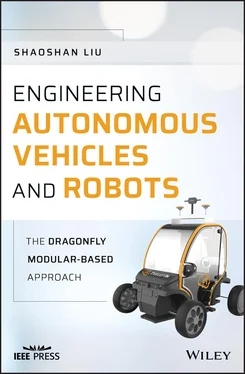1 Cover
2 1 Affordable and Reliable Autonomous Driving Through Modular Design 1 Affordable and Reliable Autonomous Driving Through Modular Design 1.1 Introduction In recent years, autonomous driving has become quite a popular topic in the research community as well as in industry, and even in the press, but besides the fact that it is exciting and revolutionary, why should we deploy autonomous vehicles? One reason is that ridesharing using clean-energy autonomous vehicles will completely revolutionize the transportation industry by reducing pollution and traffic problems, by improving safety, and by making our economy more efficient. More specifically and starting with pollution reduction: there are about 260 million cars in the US today. If we were to convert all cars to clean-energy cars, we would reduce annual carbon emissions by 800 million tons, which would account for 13.3% of the US commitment to the Paris Agreement [1]. Also, with near-perfect scheduling, if ridesharing autonomous vehicles could be deployed, the number of cars could be reduced by 75% [2]. Consequently, these two changes combined have the potential to yield an annual reduction of 1 billion tons in carbon emission, an amount roughly equivalent to 20% of the US Commitment to the Paris Agreement. As for safety improvement, human drivers have a crash rate of 4.2 accidents per million miles (PMM), while the current autonomous vehicle crash rate is 3.2 crashes PMM [3]. Yet, as the safety of autonomous vehicles continues to improve, if the autonomous vehicle crash rate PMM can be made to drop below 1, a whopping 30 000 lives could be saved annually in the US alone [4]. Lastly, consider the impact on the economy. Each ton of carbon emission has around a $220 impact on the US GDP. This means that $220 B could be saved annually by converting all vehicles to ride-sharing clean-energy autonomous vehicles [5]. Also, since the average cost per crash is about $30 000 in the US, by dropping the autonomous vehicle crash rate PMM to below 1, we could achieve another annual cost reduction of $300 B [6]. Therefore, in the US alone, the universal adoption of ride-sharing clean-energy autonomous vehicles could save as much as $520 B annually, which almost ties with the GDP of Sweden, one of the world's largest economies. Nonetheless, the large-scale adoption of autonomous driving vehicles is now meeting with several barriers, including reliability, ethical and legal considerations, and, not least of which, affordability. What are the problems behind the building and deploying of autonomous vehicles and how can we solve them? Answering these questions demands that we first look at the underlying design.
1.1 Introduction 1.2 High Cost of Autonomous Driving Technologies 1.2 High Cost of Autonomous Driving Technologies In this section we break down the costs of existing autonomous driving systems, and demonstrate that the high costs of sensors, computing systems, and High-Definition (HD) maps are the major barriers of autonomous driving deployment [7] ( Figure 1.1 ).
1.3 Achieving Affordability and Reliability 1.3 Achieving Affordability and Reliability Many major autonomous driving companies, such as Waymo, Baidu, and Uber, and several others are engaged in a competition to design and deploy the ultimate ubiquitous autonomous vehicle which can operate reliably and affordably, even in the most extreme environments. Yet, we have just seen that the cost for all sensors could be over $100 000, with the cost for the computing system another $30 000, resulting in an extremely high cost for each vehicle: a demo autonomous vehicle can easily cost over $800 000 [10]. Further, beyond the unit cost, it is still unclear how the operational costs for HD map creation and maintenance will be covered. In addition, even with the most advanced sensors, having autonomous vehicles coexist with human-driven vehicles in complex traffic conditions remains a dicey proposition. As a result, unless we can significantly drop the costs of sensors, computing systems, and HD maps, as well as dramatically improve localization, perception, and decision-making algorithms in the next few years, autonomous driving will not be universally adopted. Addressing these problems, a reliable autonomous vehicle has been developed by us and for low-speed scenarios, such as university campuses, industrial parks, and areas with limited traffic [11,12]. This approach starts with low speed to ensure safety, thus allowing immediate deployment. Then, with technology improvements and with the benefit of accumulated experience, high-speed scenarios will be envisioned, ultimately having the vehicle's performance equal that of a human driver in any driving scenario. The keys to enable affordability and reliability include using sensor fusion, modular design, and high-precision visual maps (HPVMs).
1.4 Modular Design 1.4 Modular Design Before we go into the details of the rest of this book, let us briefly go over the modular design methodology and introduce each module. Hopefully with this introduction, readers will be able to easily follow the contents of this book. Figure 1.2 shows a DragonFly Pod [13], a low-speed autonomous passenger pod built utilizing the modular design methodology described in this book. This vehicle consists of multiple components, a RTK GNSS module for localization, a DragonFly computer vision module for localization (using visual inertial odometry technology) and active perception, a mmWave radar and a sonar for passive perception, a planning and control module for real-time planning, and a chassis module. Figure 1.3 shows the architecture diagram of this design and shows how the modules interact with each other. Figure 1.2 Modular design of a DragonFly Pod. Figure 1.3 Modular design architecture.
1.5 The Rest of the Book 1.5 The Rest of the Book In the previous sections we have introduced the proposed modular design approach for building autonomous vehicles and robots. In the rest of the book, we will delve into these topics, and present the details of each module as well as how to integrate these modules to enable a fully functioning autonomous vehicle or robot. The first part of the book consists of Chapters 2 – 8 , in which we introduce each module, including communication systems, chassis technologies, passive perception technologies, localization with RTK GNSS, computer vision for perception and localization, planning and control, as well as mapping technologies. Chapter 2: In-Vehicle Communication Systems Chapter 3: Chassis Technologies for Autonomous Robots and Vehicles Chapter 4: Passive Perception with Sonar and mmWave Radar Chapter 5: Localization with RTK GNSS Chapter 6: Computer Vision for Perception and Localization Chapter 7: Planning and Control Chapter 8: Mapping The second part of the book consists of Chapters 9 and 10 , in which we present two interesting case studies: the first one is about applying the modular design to build low-speed autonomous vehicles; and the second one is about how NASA builds its space robotic explorer using a modular design approach. Chapter 9: Building the DragonFly Pod and Bus Chapter 10: Enabling Commercial Autonomous Space Robotic Explorers From our practical experiences, the capabilities of autonomous vehicles and robots are often constrained by limited onboard computing power. Therefore, in the final part of the book, we delve into state-of-the-art approaches in building edge computing systems for autonomous vehicles and robots. We will cover onboard edge computing design, vehicle-to-everything infrastructure, as well as autonomous vehicle security. Chapter 11: Edge Computing for Autonomous Vehicles Chapter 12: Innovations on the Vehicle-to-Everything Infrastructure Chapter 13: Vehicular Edge Security
1.6 Open Source Projects Used in this Book References
Читать дальше











